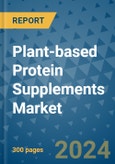The global plant-based protein supplements market is anticipated to expand at a compound annual growth rate (CAGR) of 5.4% between 2024 and 2031. The market is expected to witness an increase in revenue from US$1.14 billion in 2026 to US$1.65 billion by the end of 2031. Growing consumer interest in healthier, plant-based alternatives to meat and dairy is the primary factor driving this demand.
Market Insights Plant-based protein supplements have gained significant traction as consumers shift towards healthier lifestyles. Protein supplements, already a prominent category in the nutritional sector, are witnessing heightened popularity due to the growing plant-based trend in the food and beverage industry. A surge in veganism, increasing awareness of ethical consumption, and environmental concerns are boosting the demand for these supplements. Wheat, soy, and pea plants are the most common sources of plant-based protein supplements, with manufacturers continually investing in research and development to innovate and meet the increasing consumer demand.
This product will be delivered within 1-3 business days.
Market Insights Plant-based protein supplements have gained significant traction as consumers shift towards healthier lifestyles. Protein supplements, already a prominent category in the nutritional sector, are witnessing heightened popularity due to the growing plant-based trend in the food and beverage industry. A surge in veganism, increasing awareness of ethical consumption, and environmental concerns are boosting the demand for these supplements. Wheat, soy, and pea plants are the most common sources of plant-based protein supplements, with manufacturers continually investing in research and development to innovate and meet the increasing consumer demand.
Key Market Drivers
- Demand for Healthier Meat and Dairy Alternatives: Consumers are seeking healthier food options that meet daily protein requirements without allergens commonly found in animal-based products. Plant-based protein supplements cater to vegetarians, vegans, and those with lactose intolerance.
- Weight Management: Rising health awareness and the growing demand for weight-loss solutions are major drivers. Consumers are increasingly adopting plant-based protein diets, promoting supplements that are easily digestible and packed with essential amino acids, aiding muscle development and metabolism.
- Food Sensitivity: As food allergies, particularly lactose intolerance, become more prevalent, plant-based proteins offer a suitable alternative. These supplements are seen as a non-GMO, allergen-free substitute for dairy proteins.
Business Opportunities
- Rising Popularity of Vegan Protein Supplements: Veganism is on the rise, especially in developed regions, leading to increased sales of plant-based protein supplements. In the next few years, the adoption of vegan diets will continue to drive demand in regions like North America and Europe.
- Growth of Organic Food Blends: Consumers' preference for organic foods is expanding rapidly. The plant-based protein supplements market is set to benefit from the launch of organic product lines, appealing to health-conscious consumers looking for natural and organic options.
Key Regional Insights
- North America: With a market share of nearly 40%, North America dominates the global plant-based protein supplements market. The region benefits from its established fitness culture, leading manufacturers, and a growing interest in plant-based diets. The increasing vegan population in the U.S. and Canada is expected to propel future growth.
- India: India is the leader in the South Asia & Pacific region, accounting for over 38% of the market. This growth is driven by the country’s large vegetarian population and a growing awareness of health and fitness, making India a key player in the global market.
- Latin America: With a CAGR of 7.1%, Latin America, particularly Chile, presents significant growth potential. The region's focus on preventive healthcare and the need for weight management products will drive the demand for plant-based protein supplements.
Challenges to Market Growth
- Lack of Awareness: Despite growing interest in plant-based diets, some consumers remain unaware of plant-based protein supplements or harbor negative perceptions regarding their taste and texture.
- Premium Pricing: The high cost of plant-based protein supplements due to limited resources and processing challenges may hinder growth, particularly in developing regions where price sensitivity is high.
Key Players in the Market
- Axiom Foods
- Glanbia plc
- NOW Health Group Inc.
- MusclePharm Corporation
- Ingredion Inc.
- Roquette Frères
- DuPont
- Archer-Daniels-Midland Co.
- Batory Foods
- The Scoular Company
Plant-Based Protein Supplements Market Segmentation
By Type
- Soy Protein
- Wheat Protein
- Pea Protein
- Others
By Sales Channel
- Hypermarkets/Supermarkets
- Specialty Stores
- Pharmacy & Drug Stores
- Online Retail
By Region
- North America
- Europe
- Latin America
- Western Europe
- Eastern Europe
- South Asia and Pacific
- East Asia
- The Middle East and Africa
This product will be delivered within 1-3 business days.
Table of Contents
1. Executive Summary
2. Market Overview
3. Global Plant-based Protein Supplements Market Outlook, 2019 - 2031
4. North America Plant-based Protein Supplements Market Outlook, 2019 - 2031
5. Europe Plant-based Protein Supplements Market Outlook, 2019 - 2031
6. Asia Pacific Plant-based Protein Supplements Market Outlook, 2019 - 2031
7. Latin America Plant-based Protein Supplements Market Outlook, 2019 - 2031
8. Middle East & Africa Plant-based Protein Supplements Market Outlook, 2019 - 2031
9. Competitive Landscape
10. Appendix
Companies Mentioned
- Axiom foods
- Glanbia plc
- NOW Health Group Inc.
- MusclePharm Corporation
- Ingredion Inc.
- Roquette Frères
- DuPont
- Archer-Daniels-Midland Co.
- Batory Foods
- The Scoular Company
Methodology

LOADING...








